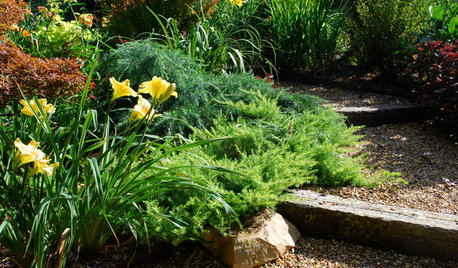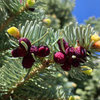Cultivar confusion/grafting mixups
Well, sorry folks, but I am back again with this topic. The more I look into the various cultivars of Norway spruce, and review what I have found out (or not), and review my experiences, the more frustrated and "hot" I get. Frankly, I think the situation is so bad that someone needs to take some action to try to sort things our and/or introduce some standards.
What has set me off again is my calling in an order to Gees, and my conversation with Kara (sp?). This is no negative reflection on GeeÂs or on Kara, but some discrepancies where highlighted in my conversations with her.
First, I have expressed my interest in a P. abies cultivar called ÂElegantissima. The cultivar Kara described to me that GeeÂs offers under this name seems quite different from what I have seen described elsewhere, and for example, offered by Forest Farm. Both the coloration (GeeÂs a predominant sulfur color throughout persisting through the summer, Forest Farm new growth yellow/yellow green, fading to mostly green with frosted tips/highlights) and the growth habit (GeeÂs regular species form, Forest Farm prominently weeping branchlets). Now there is some degree of overlap, but these seem to me to be distinctly different trees. GeeÂs takes scions from their own specimen, so I can trust their description.
Second, ÂPendula Major: I have been growing three of these, but two are of one type, and the other is distinctly different. The difference is in the growth habit. One is clearly shaped generally like the species, with weeping branchlets on a generally dense branching habit. The other is much narrower and more open, with weeping branchlets. Searching the web I find evidence, including pictures of both types going under the same name. GeeÂs is apparently the much narrower form.
Third, I recently got a P. abies ÂCincinnata from Iseli. This is in some places described as a "snake branch" spruce, but mine clearly has buds all along each new twig, not at all like the ÂVirgata I am growing and ÂCranstoniiÂ, which I have seen at the National Arboretum. Other descriptions of this cultivar describe it as an upright tree that develops very dense cascading foliage. This would seem to be a type basically opposite to the usual snake branch type.
There are many other cultivars I have seen contradictory descriptions of, some of which I have commented on before in this forum. But these three are enough for now.
Now I am wondering how these clear contradictions between Âwhat is what appear. I am wondering if at least an occasional cause can be mix-ups on the grafting bench that are somehow perpetuated. About 12 years ago I came across a really astounding--to my eyes--Norway spruce growing in a yard in WV. This tree had a normal Norway spruce habit, but all the branches growing out from the primary branches hung absolutely straight down in dense curtains up to 6 or 8 feet long. I got permission to collect scions for grafting--twice, about 6 years apart--10 scions each time which I sent to be custom grafted.
Well, let me describe the results. The first time I got two different types. One type kept growing as a side branch for so long I gave up on them. The other grew exactly like any other Norway spruce. Now maybe I needed to keep the first group staked much longer, but I was inexperienced and didnÂt know much about how patient one needs to be. But these growing as side branches did not really show the same weeping habit as the original tree.
The second time I sent scions to be grafted, I again got two that grew exactly like the species, and then another that is growing like what must be some other cultivar. It is a dwarf or semi-dwarf, growing about 6" per year in a very irregular, upright weeping habit. Of the other 7 trees I only have one surviving. I had them in a fenced enclosure and some deer apparently jumped in and couldnÂt jump out, at least not until he destroyed all but one of my remaining grafts. This one remaining tree needs to be staked for at least a while longer before I will find out what it is.
I have to think there was some mix-up on the grafting bench--or more than one mix-up. All the little trees I got were grafts, there is no doubt about that, and I cut off the rootstock portion after a year, so no mistake there.
But my failure to get this tree grafted after my two attempts is sad, because two years ago the man, who owned the tree and loved it, died--he was very old. The new owners of the house cut the amazing tree down along with its mate--there were two growing as traditional "Bride and Groom" trees. So if my last surviving graft does not contain the genetic heritage of this tree, it is lost forever. Too bad. I am not the only one who was Âstunned by this tree. The owner said that he frequently had people stop and admire the tree and ask what it was.
So, what can be done? I guess nothing about grafting mix-ups. But one thing I would like to see, failing the establishment of some central authority to describe each cultivar and set some standards for the industry, would be for each grower to post the provenance for each cultivar they sell, and if possible, a picture of the tree from which the scions are taken. I understand GeeÂs has an arboretum, and much of what they sell is grown from scions cut from their own trees. If I were closer to them, I would go and look at their trees.
Anyway, excuse the length of this post, but I am one frustrated little puppy!
Well, thanks for reading this--maybe my writing this and the idea that someone may read it has made me cool down a bit and feel better. But, of course, the frustration will reamin.
--Spruce









coniferjoy
gardener365
Related Discussions
Pictures thread - hunting for new cultivars of dwarf conifer...
Q
'Flavor' should be the base of a name cultivar!
Q
How do new cultivars come to be?
Q
Help me figure out if this growth is above-graft or below-graft
Q
gardener365
sprucemanOriginal Author
gardener365
sprucemanOriginal Author